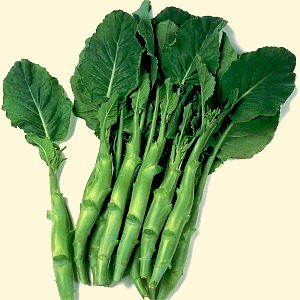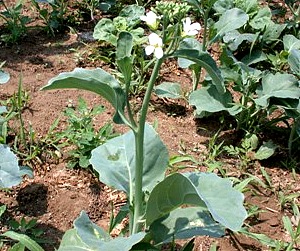 Chinese Broccoli (Brassica oleracea var. alboglabra) also known as Kai-lan, is a glossy, blue-green leaf vegetable with crisp and thick stems; and has a small number of tiny, almost vestigial flower heads similar to those of broccoli. It has a slightly more bitter flavor than broccoli, but quite delicious. Chinese Broccoli is high in calcium, iron, vitamin A and vitamin C.
Chinese Broccoli (Brassica oleracea var. alboglabra) also known as Kai-lan, is a glossy, blue-green leaf vegetable with crisp and thick stems; and has a small number of tiny, almost vestigial flower heads similar to those of broccoli. It has a slightly more bitter flavor than broccoli, but quite delicious. Chinese Broccoli is high in calcium, iron, vitamin A and vitamin C.
In Chinese cuisine, the vegetable is often boiled or steamed and served with oyster sauce; and sometimes stir-fried with ginger and garlic. It is also common in Vietnamese, Myanmar and Thai cuisine.
Chinese Broccoli can easily grow in nearly all climate zones. Sunny, fertile, well-drained garden beds are best for growing this vegetable. It’s not particularly strong, so it is advisable to provide support to protect it from windstorms.
How to grow Chinese Broccoli
Soil Type
Chinese Broccoli requires a fertile soil with good drainage and a high level of organic matter.
Climate
Chinese Broccoli is a cool season crop with some frost tolerance. It can be grown year round in the upland tropics, but the optimum variety changes during the season. Uniform conditions are favorable: not too wet, dry or shady, and not too windy when the plant is young. It is a perennial plant that is usually grown commercially as an annual.
Temperature
The optimum temperature for rapid growth is 18-28ºC. Low temperatures promote early flowering and are necessary for complete floral development. The crop is frost tolerant and more heat tolerant than other broccoli.
Plant Density
A planting layout of 2-4 rows per bed and 8-12 cm between plants gives a density of 108 000 to 220 000 plants/ha. Sow heavily and then thin after 3 weeks of growth. Thinned plants can be sold as the first harvest. A dense planting results in a high leaf area index, a desirable product and high marketable yield. It also increases time to maturity and reduces the stem mineral content, due to higher competition among plants. Seeds are sown at about 0.6 cm depth. There are approximately 200 seeds/g.
Germination
The optimum temperature for germination is 25-30ºC. Emergence occurs 3-6 days in summer and 4-10 days in autumn.
Transplants
Seedlings are transplanted at 3-4 weeks. Seedlings often grow too fast in poly houses, causing early flowering and minimal vegetative production. Growth should be monitored, particularly in warm weather. Seedling trays require wind protection but should only be stored in poly houses in cool weather.
Fertilizer
High planting densities require higher levels of N, of 400 kg/ha or more. One format is a base dressing of 500 kg/ha Pivot 800, followed by side dressings of 125 kg/ha CaNO3 or equivalent at 3 weeks after transplanting. Dual (metalochlor) at 3 L/ha is often applied directly after transplanting.
Watering
The crop requires frequent light watering for optimum growth, since it is shallow rooted.
Harvest
The crop is ready to harvest at 10 weeks from sowing in autumn and 8-9 weeks in summer. Young flowering stems are selected with compact florets and small leaves attached, and cut at 15 to 20 cm length with a sharp knife. Flavor is maximized when plants are harvested well before the buds begin to open. They should be harvested frequently to prevent bolting and toughening, particularly in summer. About three cuts can be obtained from one stem, and the main stalk should be cut relatively short to enhance further growth. A liquid feed after each harvest may benefit regrowth.
Yield
The average yield in a season with 2-3 harvests is 6-11 t/ha. Yield is dependent on harvesting frequency and method.
Pests and Diseases
A wide range of pests and diseases, common to Brassica crops, has been reported. The crop requires frequent observation and a rapid response to ensure that quality of the crop is maintained. Occasionally spraying can be avoided by harvesting the plants very young, or by growing very small amounts. Generally however, the crop is frequently sprayed to ensure that very few leaves are holed or scarred. Few chemicals are registered for use on leafy Asian vegetables. This issue is currently being addressed through a collaboration of growers and government bodies.
Post Harvest
Chinese Broccoli are best harvested in the early morning to minimize water stress, and tied into bunches of 5 to 7 plants. The main stem should be 10-15 cm long and 1.5-2.0 cm wide at the base. A shelf life of more than 21 days is possible with the correct storage. This can be increased to 27 days by removing ethylene. Shelf life at 5-10ºC is reduced to 7-14 days.
Packaging
Use of low density polyethylene bags appears to reduce flower bud deterioration, but generally does not improve storage life.
Quality Assessment
A good quality product has 15-20 cm tall green stalks and white flower buds that are developed but unopened. Common post harvest defects include open or deteriorating flowers, and yellowed or decayed leaves.
TIPS:
- When seeking out Chinese broccoli in the store, look for crisp specimens without any sign of wilting, and no soft spots or marked discolorations. The vegetable can be stored under refrigeration for up to three days, loosely wrapped in plastic in the vegetable drawer. Always wash it before using, to remove dirt or compost which may have adhered to the leaves.
Sources: en.wikipedia.org, rirdc.gov.au, wisegeek.com; Photo: vegplugs.co.uk, worldcrops.org
